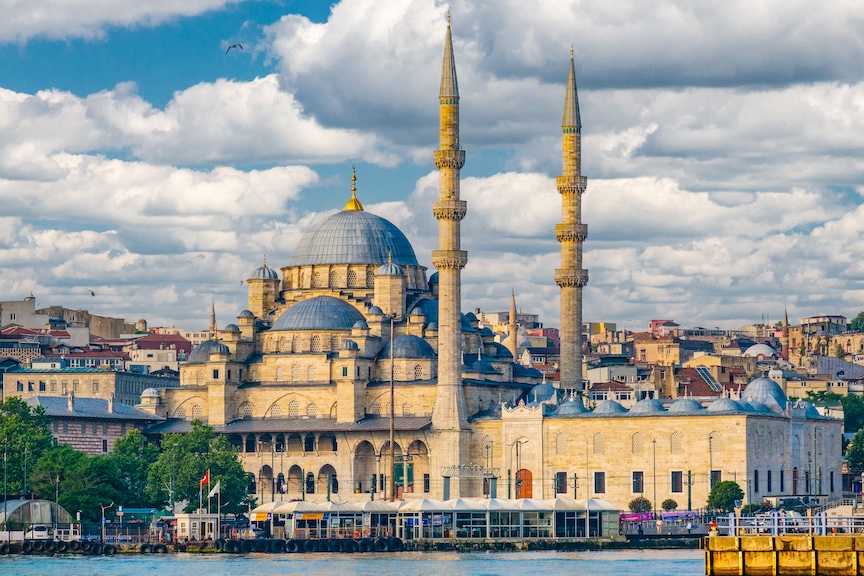
The “New Mosque” was completed in 1663 in Istanbul, Turkiye. Photo by Charles Cecil
By Charles Cecil
I remember the first time I ever entered a mosque. It was in the early 1960s. Columns decorated with colorful tiles depicting floral designs supported arches bordered with bands of floral decoration. I was transfixed by the sight as my shoeless feet sunk gently into a plush carpet covered with geometric patterns.
I looked to the front where I saw beautiful cursive Arabic calligraphy surrounding the mihrab, a semi-circular indentation in the far wall, indicating the direction toward Mecca. There were no pews, chairs, benches, or any other provision for seating. Neither could I find any representations of the human form. No faces of Muhammad or any of the other prophets like Abraham, Moses, Noah, Solomon and Jesus who preceded him. All are mentioned in the Quran; Jesus appears 25 times.
Equally surprising was the contrast to the many Buddhist, Taoist, and Shinto temples I’ve visited. There was no altar in sight, no offerings to the deity, no gifts of fruit or flowers to ancestors. What’s this all about?
Although Islam is now the third-largest religion in the United States, few Americans have ever entered a mosque. Recent estimates place the U.S. Muslim population at about 3.5 million, behind Christianity and Judaism. Mosques can now be found in most American cities, but few regard themselves as a tourist destination. Abroad, however, many countries are proud of the architectural beauty of their mosques and of their historical importance. Non-Muslim visitors are welcome in many mosques outside of the hours of prayer.
An estimated 1.8 billion people (24% of the world’s population) now identify themselves as Muslim. It’s likely that if you travel to a Muslim country, you’ll have opportunities to visit beautiful and historic mosques. Over the years I’ve had opportunities to live and work in ten Muslim countries and to visit many more. The following suggestions may help you to get the most out of visiting a mosque.
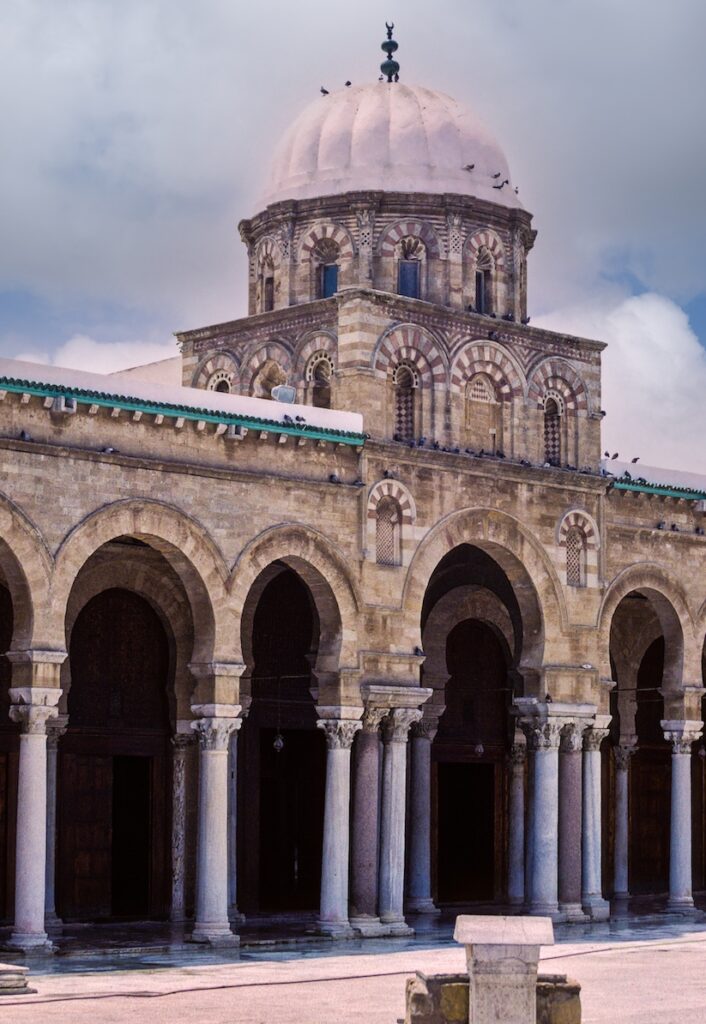
Erected in 732 AD, the Al-Zaytuna Mosque sits at the heart of Tunis’ medina. Built with rubble from the ancient city of Carthage, it is Tunisia’s best example of Islamic architecture. Photo by Charles Cecil
Who Can Enter?
Whether non-Muslims can visit a mosque varies greatly from country to country. Permission to enter may depend on local custom, or even on the attitude of the imam in charge. Some countries are eager to attract visitors interested in learning more about Islam. Others are more protective of their sanctuaries, perhaps similar to the Mormon practice of prohibiting entry into their temples for non-members of the Church of Jesus Christ of Latter-day Saints.
In Tunis, where I lived for two years, non-Muslims are allowed to view the courtyard of the Al-Zaytuna Mosque – the most historic and most important in the city – from a vantage point near the entrance. But a request to go inside will be summarily rejected. At Cote d’Ivoire’s oldest mosque, in the village of Samatiguila, I was allowed to photograph the interior from the doorway, but not to enter.
Mosques catering to tourists, such as the several historic mosques of Istanbul, welcome tourists by the hundreds during the day, but will normally ask tourists to leave before the communal prayer begins. Non-Muslim tourists would not normally be allowed entry during these times.
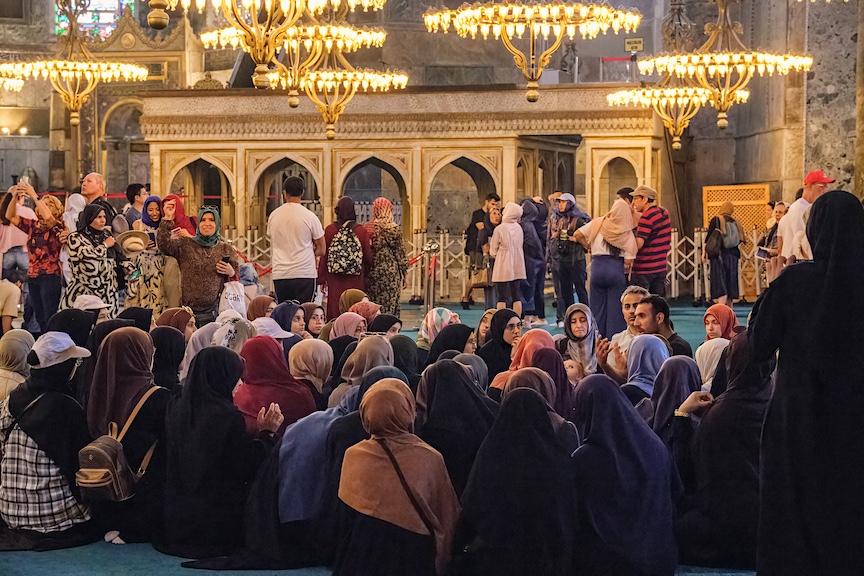
Hagia Sophia in Istanbul was built as a Christian church in the 6th century AD (532–537) under the direction of the Byzantine emperor Justinian I. In subsequent centuries it became a mosque, a museum, and in 2020 a mosque again. Although the Christian iconography has been covered, Christians still are welcome to visit and take pictures. Multilingual guides are available. Photo by Charles Cecil
Prayer Times
An individual may come and pray at any time. Five times a day, however, are designated for communal prayer, which will be led by an imam. These prayer times are known as Fajr (before dawn), Dhuhr (afternoon), Asr (late afternoon), Maghrib (after sunset), and Isha (nighttime). Worshipers always face towards the Kaaba, the shrine in Mecca that is the primary pilgrimage destination. Traditionally the prayer before dawn was to take place when there was enough morning light to enable the imam to distinguish a black thread from a white one. In modern times the prayer times are calculated astronomically. Most modern mosques have a digital clock announcing the prayer times for the day. Times also can be checked online.
Some mosques are closed to non-Muslims on Fridays, the day of communal prayer. It’s always wise to confirm local practice before going out of your way to visit a special mosque. Non-Muslims are not allowed to enter the city of Mecca at any time.
Proper Dress
Proper dress is important. Women should cover their hair and not expose their arms or legs. Mosques that welcome non-Muslim visitors will often have ankle-length outer coverings on a rack near the main entrance for borrowing for use before entering the mosque. Shoes, of course, are removed before entering. There is almost always a series of cubicles on shelves immediately inside (sometimes outside) the entrance where shoes are placed on entering. In all my years in Muslim countries, I have never heard of anyone having their shoes stolen, but if it makes you more relaxed you could carry your shoes inside in a plastic bag (not likely to be provided). Socks can be worn. Shorts for men would normally be considered inappropriate, but a man doesn’t need to cover his head, though head coverings are a part of everyday attire in many Muslim countries.
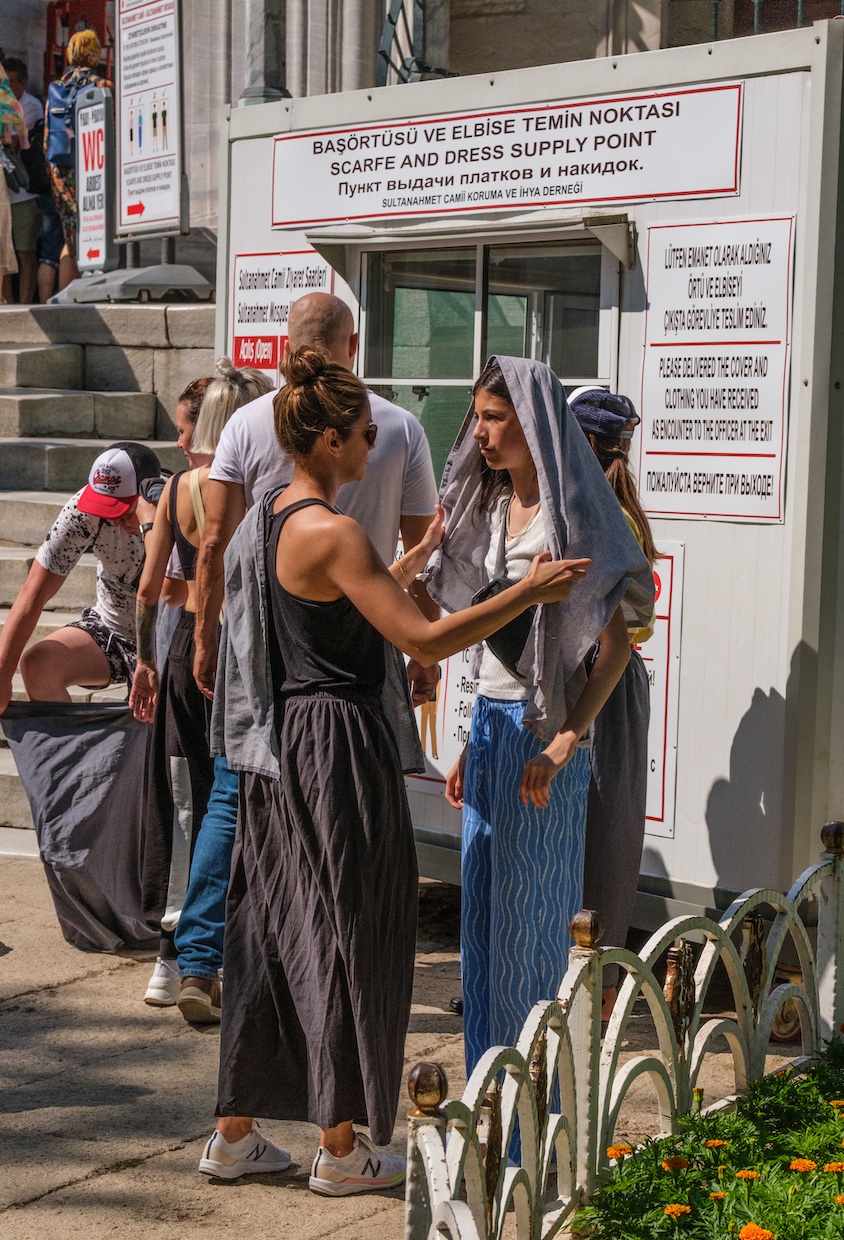
Tourists needing more conservative dress before entering the Sultan Ahmed Mosque in Istanbul, Turkiye are loaned the necessary clothing. Photo by Charles Cecil
Acceptable Tourist Behavior
Rules of behavior are dictated by common courtesy, displaying the quiet and respect one would expect in any place of worship. Make sure to turn your cell phone ringer off!
Mosques that are especially historic or whose architecture attracts interest often welcome tourists. There may be special entrances designated for tourists. Inside there may be small wooden barriers, or tapes, separating the prayer area from the viewing area created for tourists. Even Muslim tourists will usually respect these limits unless they come intending to pray.
Muslim men gather in the prayer area at any time of day, sitting or stretching out on the carpet, relaxing or chatting with friends. The mosque can serve as a meeting place for casual encounters outside the regular prayer times. Men may come and sit on the floor while they read the Quran to themselves. Sometimes an imam, using a microphone, will read from the Quran during the periods outside the times for communal prayer.
An area near the rear of the prayer area will be designated for women who have come to pray. Some may pray alone or with a friend. Others will use the area as a place to rest with friends before the communal prayer. The usual explanation for seating women behind the men is to ensure that men are not distracted by feminine beauty when they should be concentrating their attention on God (Allah).
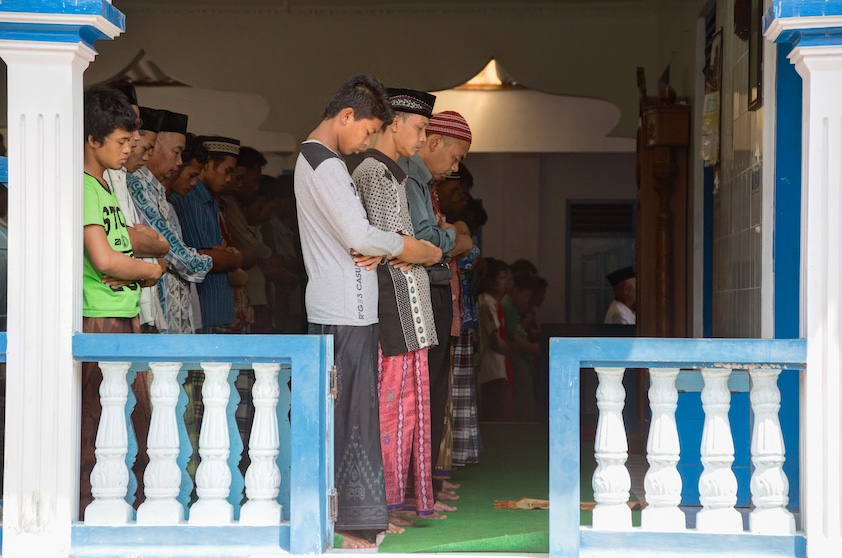
In the Indonesian city of Borobudur on the island of Java, Muslim men gather for Friday midday prayers in a neighborhood mosque. Indonesia is the world’s largest Islamic country. Photo by Charles Cecil
Islam’s Architectural Diversity
The design and appearance of mosques may be heavily influenced by the traditional architectural styles of the areas in which they are located. This may vary greatly from a Western conception of what a mosque should look like. The Gedhe Kauman Mosque of Yogyakarta, Indonesia has no visible minaret. Its roof rises to a pyramidal point with loudspeakers for announcing the call to prayer placed under the eaves of the upper level. The pyramidal roof line evokes thoughts of Mt. Meru, the center of the universe in Hindu and Buddhist cosmology.
The oldest mosque of Cote d’Ivoire, in what is considered a Malinke style, has no minaret. The Selimiye Mosque of Nicosia, Cyprus, might easily be mistaken by the casual observer (until you enter it) to be a Gothic cathedral since it was formerly the Cathedral of Saint Sophia, built before the Ottoman conquest. For a full discussion of the blending of Islamic and Chinese architectural traditions see The Back-road Historic Mosques of China.
Readers wishing to delve more deeply into the beauties of Islamic architecture should turn to Eric Brough’s Islamic Architecture: A World History, released by Thames and Hudson in September.
Common Architectural Features
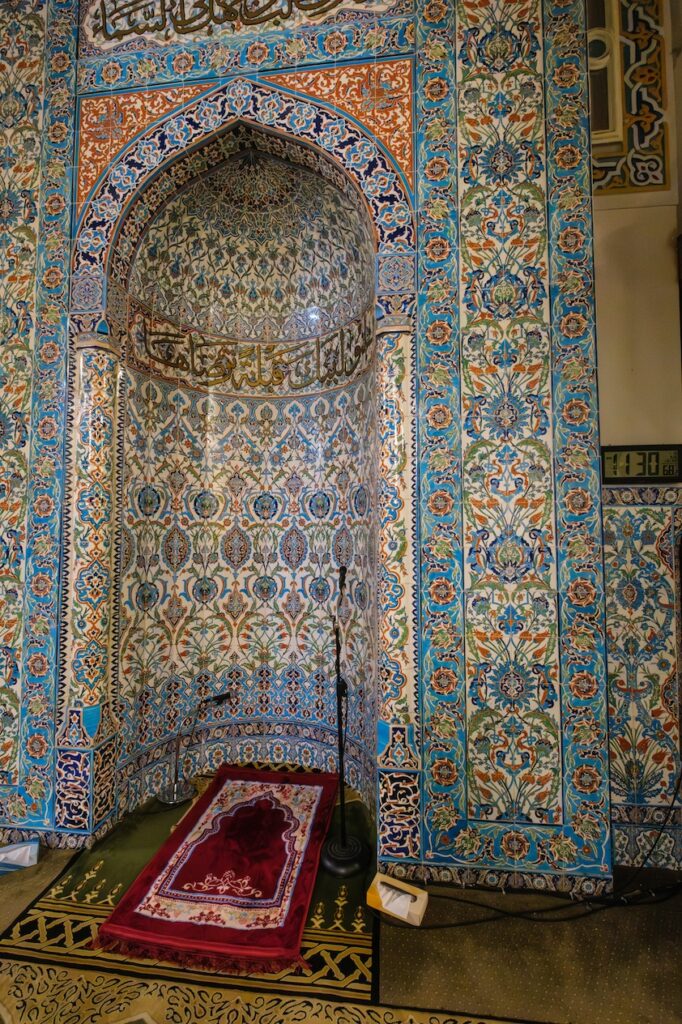
The Mihrab inside the Islamic Center mosque on Massachusetts Ave. in Washington, DC is elaborately decorated with tile. The Mihrab’s semi-circular shape orients congregants to the direction of Mecca. Photo by Charles Cecil
What should you look for on entering a mosque? If you have not been in one before you may be surprised that there are no chairs, benches, pews, or other things to sit on. (Sometimes you will find a few plastic chairs at the back, for people who have trouble kneeling, but these are not always provided.) Carpets will cover the floor, their size and quality determined by the prosperity of the local community.
Prayer involves prostration, kneeling, and standing. Though a mosque may be quite full of worshippers ranged in row after row, especially for the Friday mid-day prayer, space in front of each worshipper is required to allow for prostration. There will be no representations of human, angelic, or prophetic figures inside a mosque since a strict interpretation of Islam prohibits the reproduction of the human figure. Beautiful stonework, tiles, calligraphy, and geometric designs will be employed for decoration.
** The Mihrab The mihrab is the first thing to look for upon entering a mosque. This will be a niche, a semi-circular indentation, in the wall of the mosque, to indicate the direction of Mecca. This is the direction all Muslims must face when they pray. The mihrab is the architectural focal point of the mosque. Usually, it will be ornamented with ceramic tiles, often with Arabic calligraphy quoting verses from the Quran.
** The Minbar To the right of the mihrab is the minbar, the pulpit from which the imam will deliver the Friday sermon, or khutba, after the prayers. Normally the minbar is a series of steps allowing the imam to see over the congregation and to be seen by the worshipers, who remain seated on the floor while he speaks. Some minbars can be highly decorated with tiles, geometric designs in stone or inlaid stonework. Some can be short and very simple, depending on the wealth of the congregation.
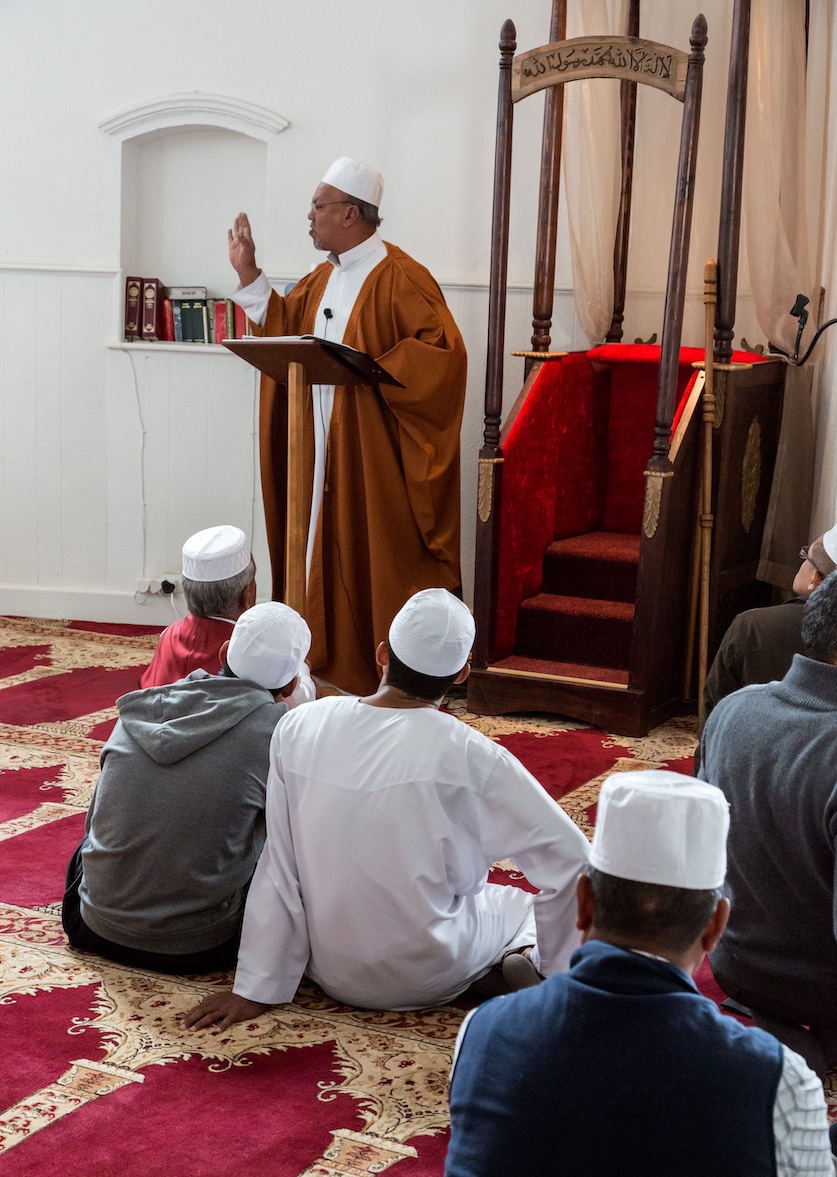
An Imam standing in front of his minbar gives the Friday sermon before prayers at the Al-Azhar mosque in Cape Town, South Africa. Photo by Charles Cecil
** The Clock Most mosques in urban areas will have a digital clock indicating the current time and the time of the daily prayers for the current day. This is often to the left of the mihrab, but this is not a hard and fast rule.
** The Minaret There is no entry to the minaret. I have never been in a mosque that allowed one to climb the minaret. Traditionally this was intended to enable the imam to be heard as he called residents to prayer. In the modern era, loudspeakers are mounted near the top and the call to prayer is broadcast electronically.
Photography
If entry is allowed, then photography will usually be permitted inside the mosque. It’s quite common to see Muslims using their cell phones to photograph themselves, their friends and the beautiful decorative features of the mosque.
The Islamic prohibition against reproducing the human figure is now very narrowly interpreted. It’s hard to walk in any urban environment in a Muslim country without seeing large photos of the president, the king, or other prominent political figures, but one will never see a reproduction of a human face inside a mosque.
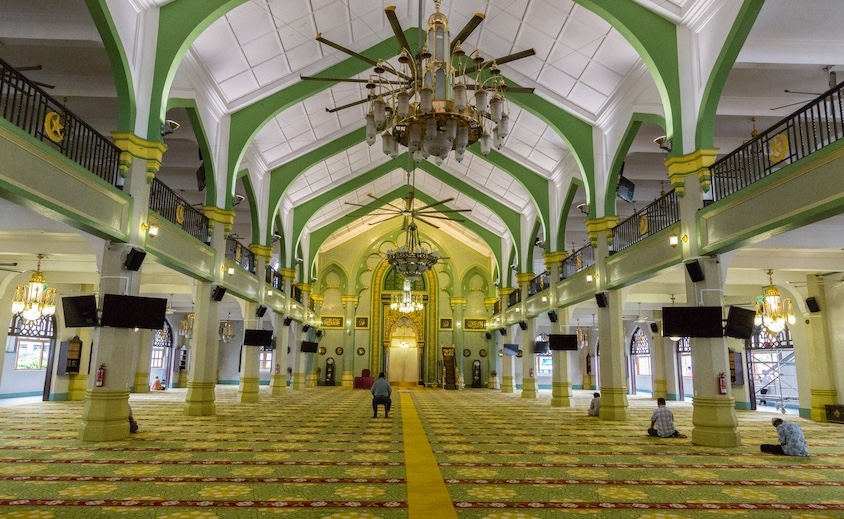
The massive interior Prayer Hall in Singapore’s Masjid Sultan in Kampong Glam fills up quickly when congregants begin arriving for Friday prayers. Look closely and try to spot the Mihrab at the far wall. Photo by Charles Cecil
If I want to photograph worshipers I normally just sit down near the back or along the side, resting against a wall or a column, and sit quietly with my camera. Permissiveness varies according to the local culture, and one must be sensitive to this. I would not try this in Afghanistan. In Cape Town, however, the imam, who traced his lineage back to Malaysia, told me I was free to attend prayers and to take any photos I wanted, even moving to another location during prayers if necessary. “Feel at home,” he said.
It isn’t necessary to travel abroad to visit a mosque. Visitors to Washington, D.C. can visit the Islamic Center and mosque on Massachusetts Avenue outside of scheduled prayer times. When it opened in 1957 it was the largest mosque in the Western hemisphere.
If you live in a reasonably large town or city there is probably a mosque in your area. An online search will quickly find it.
Many countries, using government funds, have built large and beautiful mosques and are proud to display them to visitors. By showing respect and observing a few natural courtesies you should be able to enjoy visiting these wonderful examples of Islamic heritage, adding significantly to the pleasure of your visit. Hopefully, these tips will enable you to get maximum benefit from your visit.![]()
Ambassador Charles O. Cecil’s 36-year diplomatic career included assignments in ten Muslim countries. He now devotes himself to international travel writing and photography. His photos of Senegal’s Goree Island and the Himalayan Kingdom of Bhutan can be seen elsewhere on this website.

